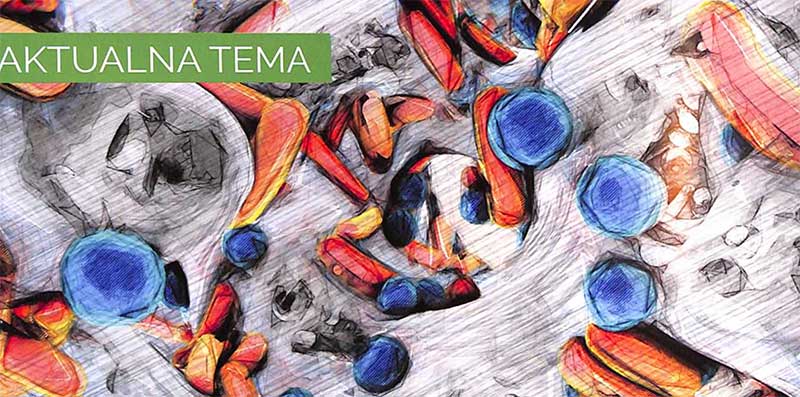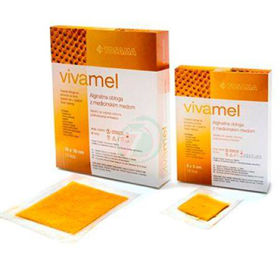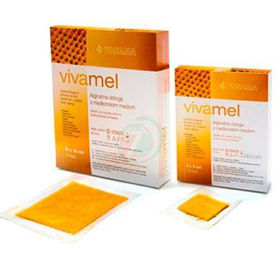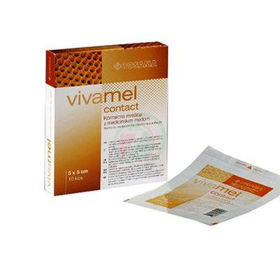Bacteria form a biofilm in 99.9% of chronic wounds.

Wound healing is known to be highly dependent on microbial load, including biofilm.
A biofilm is a collection of slow-growing bacterial cells that form a polysaccharide protective coat. Bacteria can live in nature as free bacteria, in the so-called planktonic form, and more often they combine into related biofilm formations. Planktonic bacteria get into a favorable environment (need a humid environment), attach to the substrate in a few seconds to minutes and are surrounded by a polymer matrix like a dome (made of polysaccharides, proteins and nucleic acids), which protects them from external influences, antibiotics and immune by the response of the host. Under the dome, which is permeable to oxygen and nutrients, they reproduce and expand into colonies, and the degradation products are released into the environment through the water channels through which the colony is interspersed.
Biofilm on wounds inhibits granulation, epithelialization and leads to a more violent inflammatory phase, which prolongs healing. However, because the bacteria in the biofilm are well organized, removing the biofilm from the wounds is difficult.
Debridement is required and then the wound is treated with modern dressings that provide antimicrobiality, otherwise we risk the re-emergence of biofilm (biofilm can be built in a few hours, but certainly within a day).
Therapies of the future represent the treatment of wounds with agents that would affect the microbiome in the wound, act on molecules that serve bacteria for intercellular communication called quorum sensing (QS), and that would degrade the polysaccharide matrix of the biofilm.
Chestnut honey effectively destabilizes the biofilm
Medicinal honey compresses have proven successful in combating biofilm. Research has confirmed that it most successfully destabilizes and prevents the formation of chestnut honey biofilm. For years, it stands out for its high value of kinurenic acid (up to 6 times higher content than for other species), which inhibits QS among bacteria and thus destabilizes and prevents the formation of biofilm.
In addition, due to its high sugar content, honey also stimulates autolytic debridement, which greatly reduces the microbial load.
It triggers debridment and the local immune system
Honey as a saturated solution of sugars according to the principle of osmosis causes the drawing of fluid from the tissue. Osmosis therefore increases perfusion in the wound area, which softens and dissolves the corpses in it to recede without pain, while also massively attracting leukocytes to the wound area.
The antimicrobial action of honey is supported by three mechanisms. The first is based on the physical properties of honey: in addition to the osmotic pressure, which dehydrates microbes, the pH of honey (3.4 - 6) also creates an environment in the wound in which microbes in the wound develop poorly. The enzyme glucose oxidase, which is secreted by the bee from the hypopharyngeal glands into chestnut honey, additionally contributes to the bacteriostatic action of honey. The enzyme is activated by diluting the honey (upon contact of the honey with the secretion) and triggers a reaction in which gluconic acid and hydrogen peroxide are released. This further lowers the pH and inhibits the growth of microorganisms and accelerates granulation. The third mechanism is contributed by antimicrobial peptides (AMPs) in honey, which are part of the reborn immune system of organisms and have an antimicrobial effect on a wide range of bacteria.
Facilitated proliferation
Only when the wound is cleansed can the full construction of new tissue, proliferation, which includes granulation and epithelialization, begin in full. Chestnut honey contains a lot of potassium, calcium, zinc, manganese and proline, which stimulate the synthesis of collagen, which gives the newly formed tissue the necessary strength. The controlled release of hydrogen peroxide also contributes to the formation of collagen, which also promotes the formation of other connective tissue components and angiogenesis. Honey, with its acidic pH, regulates the amount of metalloproteinases and generally provides a favorable environment for healing. It also provides new cells with a basic source of energy, sugar.
Vivamel dressings provide a modern and comprehensive way of healing wounds
Vivamel are products whose main active ingredient is medicinal chestnut honey, ie sterile chestnut honey. Among other types of honey, chestnut honey stands out due to its high content of enzymes, vitamins, minerals, flavonoids, aromatic acids and amino acids. Vitamin C, the elements potassium, calcium and manganese, the amino acid proline, kinurenic acid and the enzyme glucose oxidase are particularly important for wound healing.
Exclusively grown chestnut honey in 100% concentration, without added thickeners, applied to Vivamelja coatings.
Vivamel promotes debridment and wound cleansing, enables moist healing, has anti-inflammatory and antimicrobial effects, prevents and destabilizes the biofilm, reduces unpleasant odors and accelerates granulation and epithelialization. Physicochemical and microbiological analyzes have demonstrated the remarkable effects of Vivamel products on wound healing. The effectiveness was confirmed by a clinical study, which included wounds of various etiologies: venous ulcers, diabetic wounds. pressure ulcers, infected wounds. skin metastases, burns, to the Norwegian site, odorless wounds, surgical wounds, moist necrosis, and acute wounds.













